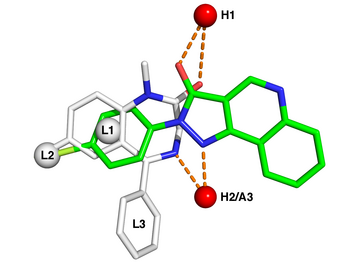
Medicinal or pharmaceutical chemistry is a scientific discipline at the intersection of chemistry and pharmacy involved with designing and developing pharmaceutical drugs. Medicinal chemistry involves the identification, synthesis and development of new chemical entities suitable for therapeutic use. It also includes the study of existing drugs, their biological properties, and their quantitative structure-activity relationships (QSAR).[1][2]
Medicinal chemistry is a highly interdisciplinary science combining organic chemistry with biochemistry, computational chemistry, pharmacology, molecular biology, statistics, and physical chemistry.
Compounds used as medicines are most often organic compounds, which are often divided into the broad classes of small organic molecules (e.g., atorvastatin, fluticasone, clopidogrel) and "biologics" (infliximab, erythropoietin, insulin glargine), the latter of which are most often medicinal preparations of proteins (natural and recombinant antibodies, hormones etc.). Medicines can also be inorganic and organometallic compounds, commonly referred to as metallodrugs (e.g., platinum, lithium and gallium-based agents such as cisplatin, lithium carbonate and gallium nitrate, respectively). The discipline of Medicinal Inorganic Chemistry investigates the role of metals in medicine (metallotherapeutics), which involves the study and treatment of diseases and health conditions associated with inorganic metals in biological systems. There are several metallotherapeutics approved for the treatment of cancer (e.g., contain Pt, Ru, Gd, Ti, Ge, V, and Ga), antimicrobials (e.g., Ag, Cu, and Ru), diabetes (e.g., V and Cr), broad-spectrum antibiotic (e.g., Bi), bipolar disorder (e.g., Li).[3][4] Other areas of study include: metallomics, genomics, proteomics, diagnostic agents (e.g., MRI: Gd, Mn; X-ray: Ba, I) and radiopharmaceuticals (e.g., 99mTc for diagnostics, 186Re for therapeutics).
In particular, medicinal chemistry in its most common practice—focusing on small organic molecules—encompasses synthetic organic chemistry and aspects of natural products and computational chemistry in close combination with chemical biology, enzymology and structural biology, together aiming at the discovery and development of new therapeutic agents. Practically speaking, it involves chemical aspects of identification, and then systematic, thorough synthetic alteration of new chemical entities to make them suitable for therapeutic use. It includes synthetic and computational aspects of the study of existing drugs and agents in development in relation to their bioactivities (biological activities and properties), i.e., understanding their structure–activity relationships (SAR). Pharmaceutical chemistry is focused on quality aspects of medicines and aims to assure fitness for purpose of medicinal products.[5]
At the biological interface, medicinal chemistry combines to form a set of highly interdisciplinary sciences, setting its organic, physical, and computational emphases alongside biological areas such as biochemistry, molecular biology, pharmacognosy and pharmacology, toxicology and veterinary and human medicine; these, with project management, statistics, and pharmaceutical business practices, systematically oversee altering identified chemical agents such that after pharmaceutical formulation, they are safe and efficacious, and therefore suitable for use in treatment of disease.
- ^ Davis A, Ward SE, eds. (2015). The Handbook of Medicinal Chemistry. Royal Society of Chemistry. doi:10.1039/9781782621836. ISBN 978-1-78262-419-6.
- ^ Barret R (2018). Medicinal Chemistry: Fundamentals. London: Elsevier. ISBN 978-1-78548-288-5.
- ^ Hanif M, Yang X, Tinoco AD, Plażuk D (2020-05-28). "Editorial: New Strategies in Design and Synthesis of Inorganic Pharmaceuticals". Frontiers in Chemistry. 8: 453. Bibcode:2020FrCh....8..453H. doi:10.3389/fchem.2020.00453. PMC 7270431. PMID 32548093.
- ^ Anthony EJ, Bolitho EM, Bridgewater HE, Carter OW, Donnelly JM, Imberti C, et al. (November 2020). "Metallodrugs are unique: opportunities and challenges of discovery and development". Chemical Science. 11 (48): 12888–12917. doi:10.1039/D0SC04082G. PMC 8163330. PMID 34123239.
- ^ Roughley SD, Jordan AM (May 2011). "The medicinal chemist's toolbox: an analysis of reactions used in the pursuit of drug candidates". Journal of Medicinal Chemistry. 54 (10): 3451–3479. doi:10.1021/jm200187y. PMID 21504168.